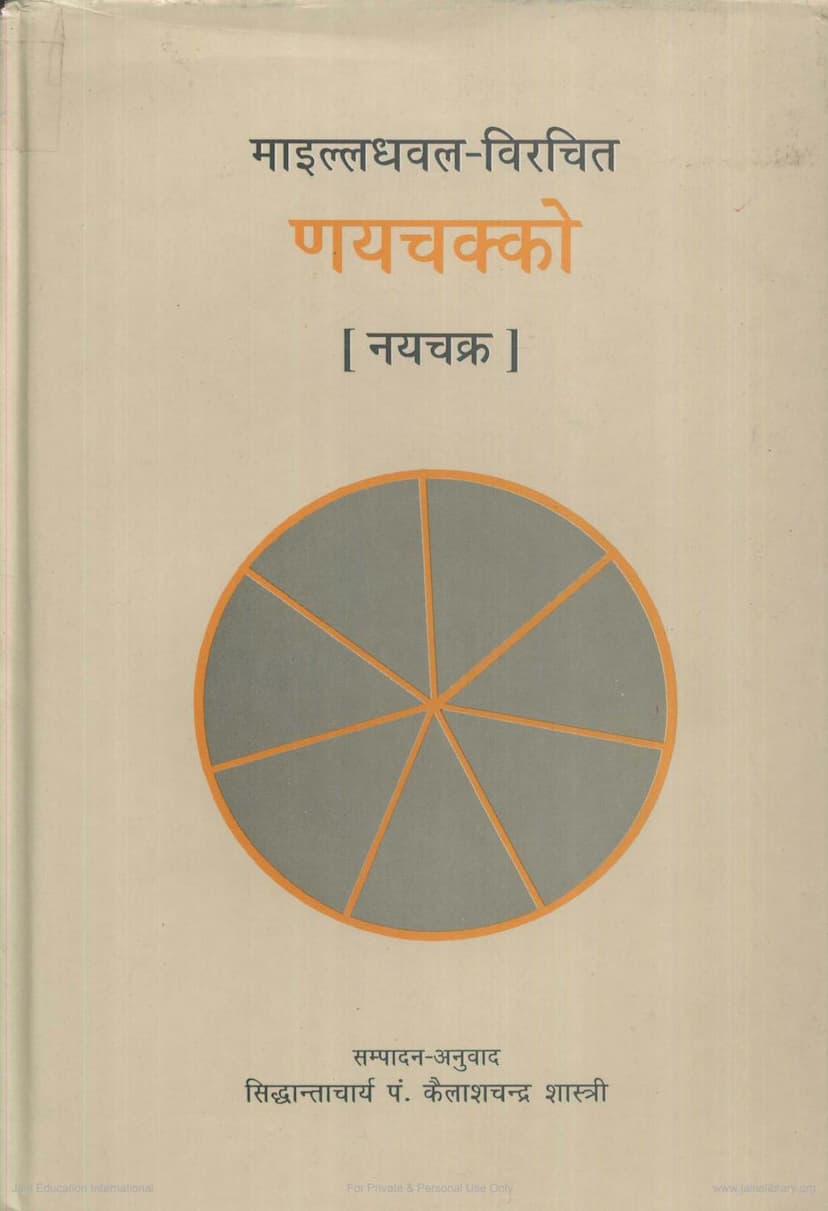Naychakko
Added to library: September 2, 2025

Summary
Here is a comprehensive summary of the Jain text "Nayachakko" by Mailldhaval, edited and translated by Kailashchandra Shastri, published by Bharatiya Jnanpith:
Title: Nayachakko (The Wheel of Nayas) Author: Mailldhaval (Author of the original text) Editor & Translator: Pt. Kailash Chandra Shastri Publisher: Bharatiya Jnanpith Series: Moortidevi Jain Granthamala : Prakrit Series No. 12 Second Edition: 1999
Core Subject: The text is a significant Jain work focused on the concept of Naya (viewpoint or perspective) within Jain philosophy. It is considered essential for a complete understanding of Jain Dharma.
Introduction and Significance:
- Naya and Pramana: The text emphasizes that knowledge of Naya and Pramana (means of valid knowledge) is crucial for understanding the true nature of reality according to Jainism.
- Foundation of Anekantavada: Naya is presented as the fundamental basis of Anekantavada (the doctrine of manifold aspects of reality).
- Historical Context: The introduction notes that ancient Jain Acharyas, like Kundakunda and Samantabhadra, composed works in Prakrit on the subject of Naya, a fact supported by references within Nayachakko.
- Mailla Dhavala's Contribution: Nayachakko itself is considered a superior and highly important work by Acharya Mailla Dhavala. While influenced by Devasena's Nayachakra, it is praised for its authenticity and comprehensiveness, making it a valuable resource for clarifying the entire subject of Naya.
- Scope: The discussion of Naya involves understanding the differences in the methods of expression between Dravya (substance) and Paryaya (modes), leading to their various classifications. Naya is one of the twelve divisions that elucidate the nature of Dravya. Therefore, the book extensively describes Nayas to explain Dravya, Guna (quality), and Paryaya, highlighting its crucial role in grasping the Jain understanding of reality.
Key Aspects of the Text and its Content:
- The Author (Mailla Dhavala): The author's identity is not widely known from other sources, and this appears to be his sole surviving work. He is placed chronologically after Devasena (c. 933 AD) and before Asadhara (c. 1136-1243 AD), suggesting a period between the 12th and 13th centuries AD. Mailla Dhavala is noted for incorporating extensive material from Kundakunda's works, enriching the Nayachakra with topics related to Dravya-svabhava (the inherent nature of substance).
- Structure and Topics: The work, consisting of 425 Gathas (verses), is divided into twelve chapters covering essential Jain philosophical concepts:
- Guna (Quality)
- Paryaya (Modes)
- Dravya (Substance)
- Panchastikaya (The Five Categories of Existence)
- Sapta Tattva (The Seven Realities)
- Nava Padartha (The Nine Substances/Categories)
- Pramana (Means of Knowledge)
- Naya (Viewpoints)
- Nikshepa (Classification/Methodology)
- Samyak Darshana (Right Faith)
- Samyak Jnana (Right Knowledge)
- Samyak Charitra (Right Conduct) This structure shows a comprehensive approach, starting with logical/epistemological topics (Nyaya) and expanding to cover almost every aspect of Jainism, integrating the teachings of Kundakunda.
- Language: The author follows the tradition of great Acharyas like Kundakunda, Nemicandra, and Devasena by composing in Prakrit (Sauraseni).
- Influence of Devasena: Mailla Dhavala's work is influenced by Devasena's Nayachakra and even incorporates a significant number of Devasena's verses (approximately 78 out of 87).
- Comprehensive Coverage: The author aims for a comprehensive exposition, qualifying his work as Dravya-svabhava-prakāśaka Nayachakra (Nayachakra illuminating the nature of substance) to indicate its broader scope beyond just Nayas, including discussions on Dravya, Guna, and Paryaya.
- Inclusion of Related Texts: The Bharatiya Jnanpith edition, edited by Pt. Kailash Chandra Shastri, is enriched by including the Alapapaddhati (a Sanskrit commentary on Devasena's Nayachakra discussing Dravya, Guna, and Paryaya) and the Nayavivarana (extracted from Vidyananda's Tattvarthashloka-varttika) along with Hindi translations. This makes the volume a valuable source book on Nayas.
- Philosophical Underpinnings: The text delves into:
- Anekantavada: Reality is multifaceted, and human perception is limited to its viewpoint.
- Syadvada: The doctrine of relative predication is implicitly linked to Naya.
- Dravya, Guna, Paryaya: The interplay of substance, its eternal qualities, and its transient modes is explained through the lens of Naya.
- Nishchaya Naya vs. Vyavahara Naya: The text elaborates on the distinction between the ultimate (essential) and conventional (practical) viewpoints, crucial for spiritual progress.
- Reconciling Apparent Contradictions: Nayas are used to reconcile seemingly contradictory attributes of reality.
- Editorial Work: Pt. Kailash Chandra Shastri is recognized for his deep traditional scholarship, balanced outlook, and clarity of exposition. His introduction provides valuable information about the authors and contents, and his footnotes offer parallel passages from other works.
Summary of Key Jain Concepts Discussed Through Nayas:
- Dravya, Guna, Paryaya: The text explains how different Nayas focus on the substance (Dravya) that persists through change, its inherent qualities (Guna), and its changing modes (Paryaya). For example, the Dravyarthika Naya focuses on the substance, while the Paryayarthika Naya focuses on the modes.
- Anekantavada and Relativity: The core idea is that reality has multiple facets (Anekanta). Each Naya captures one aspect, and understanding the whole requires considering all Nayas. No single Naya is absolutely correct in isolation; their validity is relative to the context and viewpoint.
- Nishchaya vs. Vyavahara: The text explains how Nishchaya Naya refers to the ultimate reality (e.g., the soul's pure nature), while Vyavahara Naya refers to the conventional or practical reality (e.g., the soul as embodied, as experiencing karma). Both are necessary for a complete understanding, but Nishchaya Naya is ultimately the path to liberation.
- Types of Nayas: While the foundational division is Dravyarthika and Paryayarthika, the text delves into further classifications like Naigama, Sangraha, Vyavahara, Rijusutra, Shabda, Samabhirudha, and Evambhuta, explaining how each emphasizes a particular aspect or perspective in understanding reality.
Overall Contribution:
Nayachakko is a foundational text in Jain epistemology and metaphysics. It provides a systematic framework for understanding reality from multiple viewpoints, which is central to the Jain philosophical system. The edition by Pt. Kailash Chandra Shastri makes this complex subject accessible and comprehensive for modern readers, especially through the inclusion of translations and annotations. It serves as a vital tool for anyone seeking a deep and nuanced understanding of Jain teachings.